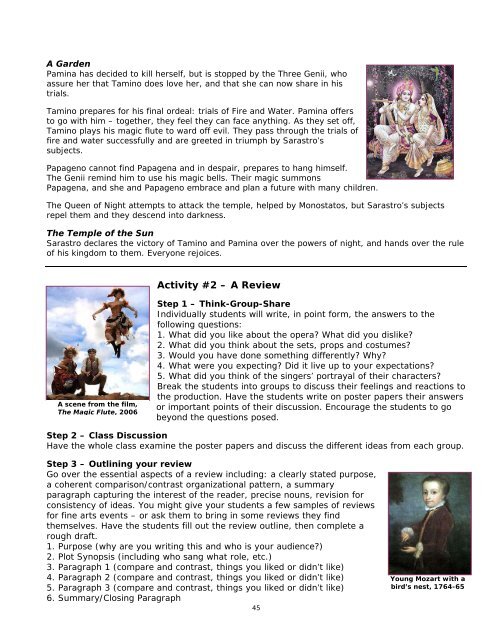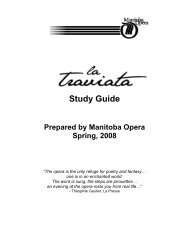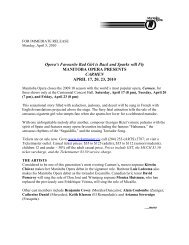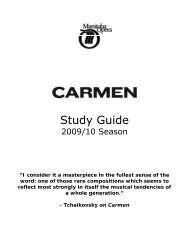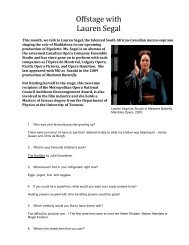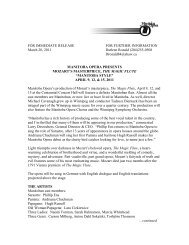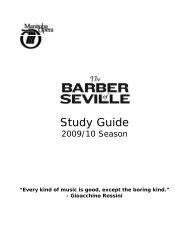The Magic Flute Study Guide - Manitoba Opera
The Magic Flute Study Guide - Manitoba Opera
The Magic Flute Study Guide - Manitoba Opera
You also want an ePaper? Increase the reach of your titles
YUMPU automatically turns print PDFs into web optimized ePapers that Google loves.
A Garden<br />
Pamina has decided to kill herself, but is stopped by the Three Genii, who<br />
assure her that Tamino does love her, and that she can now share in his<br />
trials.<br />
Tamino prepares for his final ordeal: trials of Fire and Water. Pamina offers<br />
to go with him – together, they feel they can face anything. As they set off,<br />
Tamino plays his magic flute to ward off evil. <strong>The</strong>y pass through the trials of<br />
fire and water successfully and are greeted in triumph by Sarastro’s<br />
subjects.<br />
Papageno cannot find Papagena and in despair, prepares to hang himself.<br />
<strong>The</strong> Genii remind him to use his magic bells. <strong>The</strong>ir magic summons<br />
Papagena, and she and Papageno embrace and plan a future with many children.<br />
<strong>The</strong> Queen of Night attempts to attack the temple, helped by Monostatos, but Sarastro’s subjects<br />
repel them and they descend into darkness.<br />
<strong>The</strong> Temple of the Sun<br />
Sarastro declares the victory of Tamino and Pamina over the powers of night, and hands over the rule<br />
of his kingdom to them. Everyone rejoices.<br />
A scene from the film,<br />
<strong>The</strong> <strong>Magic</strong> <strong>Flute</strong>, 2006<br />
Activity #2 – A Review<br />
Step 1 – Think-Group-Share<br />
Individually students will write, in point form, the answers to the<br />
following questions:<br />
1. What did you like about the opera? What did you dislike?<br />
2. What did you think about the sets, props and costumes?<br />
3. Would you have done something differently? Why?<br />
4. What were you expecting? Did it live up to your expectations?<br />
5. What did you think of the singers’ portrayal of their characters?<br />
Break the students into groups to discuss their feelings and reactions to<br />
the production. Have the students write on poster papers their answers<br />
or important points of their discussion. Encourage the students to go<br />
beyond the questions posed.<br />
Step 2 – Class Discussion<br />
Have the whole class examine the poster papers and discuss the different ideas from each group.<br />
Step 3 – Outlining your review<br />
Go over the essential aspects of a review including: a clearly stated purpose,<br />
a coherent comparison/contrast organizational pattern, a summary<br />
paragraph capturing the interest of the reader, precise nouns, revision for<br />
consistency of ideas. You might give your students a few samples of reviews<br />
for fine arts events – or ask them to bring in some reviews they find<br />
themselves. Have the students fill out the review outline, then complete a<br />
rough draft.<br />
1. Purpose (why are you writing this and who is your audience?)<br />
2. Plot Synopsis (including who sang what role, etc.)<br />
3. Paragraph 1 (compare and contrast, things you liked or didn’t like)<br />
4. Paragraph 2 (compare and contrast, things you liked or didn’t like)<br />
5. Paragraph 3 (compare and contrast, things you liked or didn’t like)<br />
6. Summary/Closing Paragraph<br />
45<br />
Young Mozart with a<br />
bird’s nest, 1764-65


